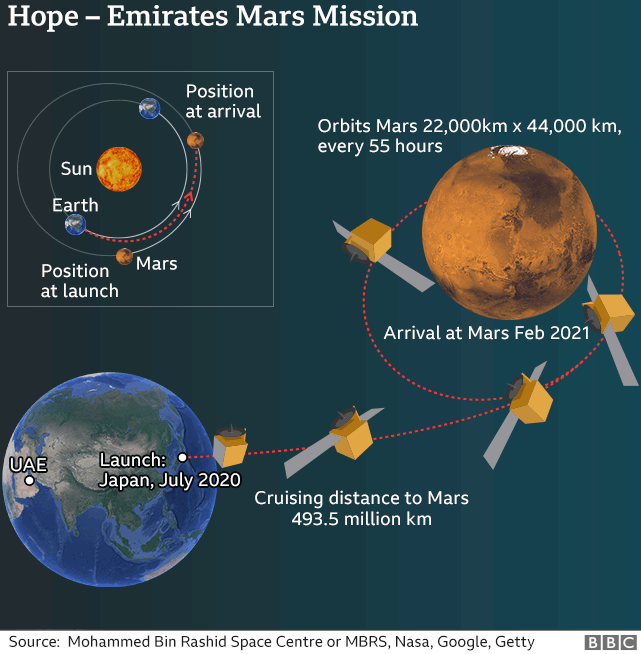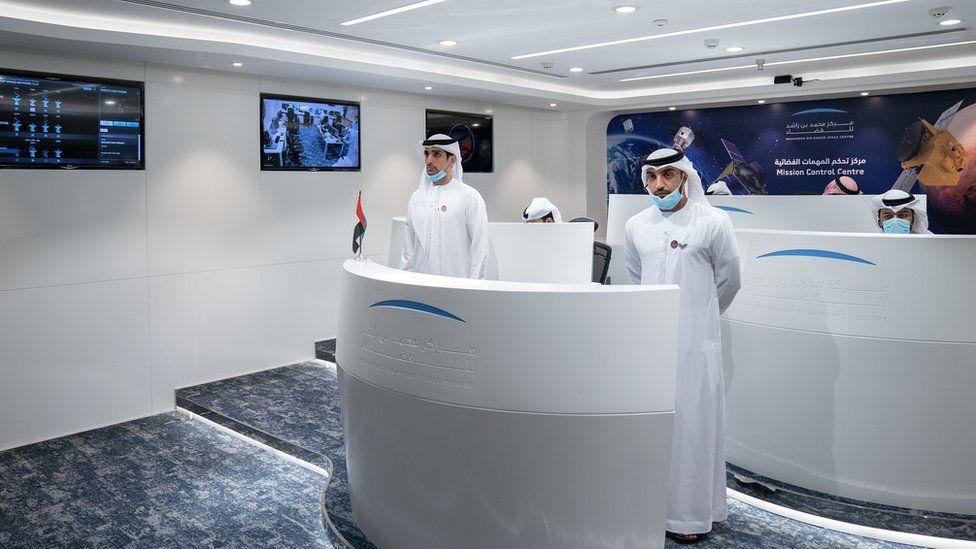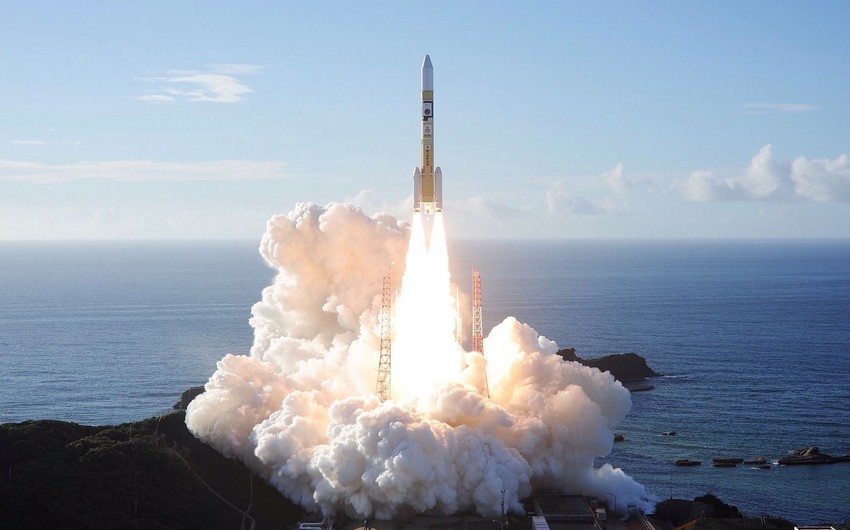After a successful lift-off in Japan, the United Arab Emirates' historic first mission to Mars is underway.
The Hope probe launched on an H2-A rocket from Tanegashima spaceport and is now on a 500-million-km journey to study the planet's weather and climate.
Two previous attempts to launch the probe in the past week had to be called off because of adverse weather.
Hope's arrival in February 2021 is set to coincide with the 50th anniversary of the UAE's formation.
Her Excellency Sarah Al Amiri, the science lead on Hope, spoke of her excitement and relief in seeing the rocket climb successfully into the sky. And she stated the impact on her country would be the same as that on America when its people watched the Apollo 11 Moon landing 51 years ago, also on 20 July.
"It was an anchor for an entire generation that stimulated everyone who watched it push further and dream bigger," she told BBC News.
"Today, I am glad that the children in the Emirates will wake up on the morning of 20 July having an anchor project of their own, having a new reality, having new possibilities, allowing them ,to contribute further and creating a larger impact on the world."
The UAE craft is one of three missions heading to Mars this month.
The US and China both have surface rovers in the late stages of preparation. The American mission, Perseverance, sent its congratulations to Hope. "I cannot wait to join you on the journey!" its Twitter account said.

Why is the UAE going to Mars?
The UAE has limited experience of designing and manufacturing spacecraft - and yet here it is attempting something only the US, Russia, Europe, and India have succeeded in doing. But it speaks to the Emiratis' ambition that they should dare to take on this challenge.
Their engineers, mentored by American experts, have produced a sophisticated probe in just six years - and when this satellite gets to Mars, it's expected to deliver novel science, revealing fresh insights on the workings of the planet's atmosphere.
In particular, scientists think it can add to our understanding of how Mars lost much of its air and with it a great deal of its water.
The Hope probe is regarded very much as a vehicle for inspiration - something that will attract more young people in the Emirates and across the Arab region to take up the sciences in school and in higher education.
The satellite is one of several projects the UAE government says signals its intention to move the country away from a dependence on oil and gas and towards a future based on a knowledge economy.
But as ever when it comes to Mars, the risks are high. Half of all missions sent to the Red Planet have ended in failure. Hope project director, Omran Sharaf, recognizes the dangers but insists his country is right to try.
"This is a research and development mission, and, yes, failure is an option," he told BBC News.
"However, failure to progress as a nation is not an option. And what matters the most here is the capacity and the capability that the UAE gained out of this mission, and the knowledge it brought into the country."

How has the UAE managed to do this?
The UAE government told the project team it couldn't purchase the spacecraft from a big, foreign corporation; it had to build the satellite itself.
This meant going into partnership with American universities that had the necessary experience. Emirati and US engineers and scientists worked alongside each other to design and build the spacecraft systems and the three onboard instruments to study the planet.
While much of the satellite's fabrication occurred at the at the University of Colorado, Boulder, considerable work was also undertaken at the in Dubai.
LASP's Brett Landin believes the Emiratis are now in a great place to do another mission on their own.
"I could give you the process for fuelling a spacecraft, but until you've put on an escape suit and transferred 800kg of highly volatile rocket fuel from storage tanks into the spacecraft, you don't really know what it's like," the senior systems engineer said.
"Their propulsion engineers have now done it, and they know how to do it the next time they build a spacecraft."
What science will Hope do at Mars?
The Emiratis didn't want to do "me too" science; they didn't want to turn up at the Red Planet and repeat measurements that had already been made by others. So they went to a US space agency (Nasa) advisory committee called the and asked what research a UAE probe could usefully add to the current state of knowledge.
MEPAG's recommendations framed Hope's objectives. In one line, the UAE satellite will study how energy moves through the atmosphere - from bottom to top, at all times of day, and through all the seasons of the year.
It will track features such as lofted dust, which on Mars hugely influences the atmosphere's temperature.
It will also look at what's happening with the behavior of neutral atoms of hydrogen and oxygen right at the top of the atmosphere. There's a suspicion these atoms play a significant role in the ongoing erosion of Mars' atmosphere by the energetic particles that stream away from the Sun.
This plays into the story of why the planet is now missing most of the water it clearly had early in its history.
To gather its observations, Hope will take up a near-equatorial orbit that stands off from the planet at a distance of 22,000km to 44,000km.
"The desire to see every piece of real estate at every time of day ended up making the orbit very large and elliptical," explained the core science team lead on Hope, David Brain from LASP.
"By making those choices, we will, for example, be able to hover over Olympus Mons (the largest volcano in the Solar System) as Olympus Mons moves through different times of the day. And at other times, we'll be letting Mars spin underneath us.
"We'll get full disc images of Mars, but our camera has filters, so we'll be doing science with those images - getting global views with different goggles on if you like."
To the : Congratulations on your launch! I wish you a successful journey and look forward to the sol when we are both exploring Mars.
— NASA's Perseverance Mars Rover (@NASAPersevere)
رØÙØ© Ù ÙÙÙØ©


 https://static.report.az/photo/f343f115-8004-3740-92c6-ff0f9f35b0f6.jpg
https://static.report.az/photo/f343f115-8004-3740-92c6-ff0f9f35b0f6.jpg

